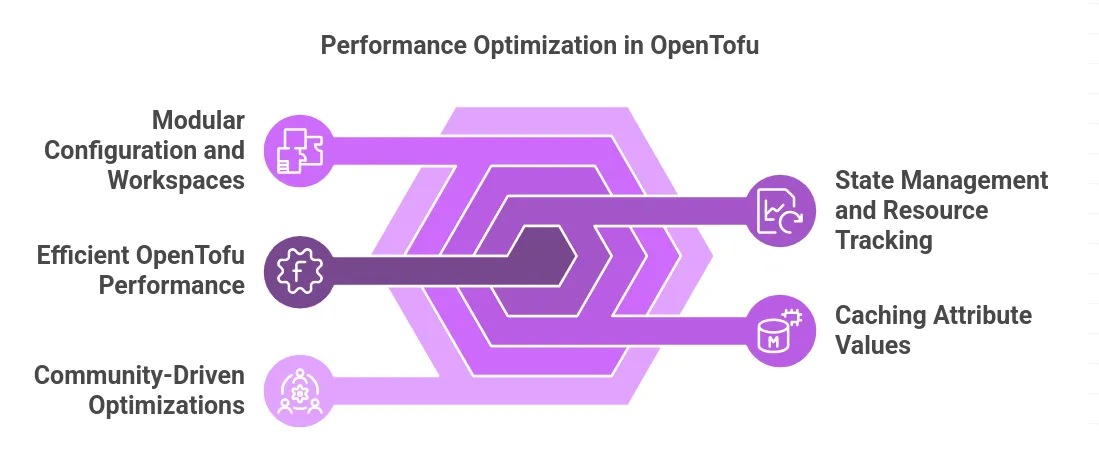January 29, 2025
Performance Optimization in OpenTofu: Best Practices

By Rakshit Menpara
Improwised Technologies Pvt. Ltd.
This blog will delve into the technical aspects and best practices for optimizing OpenTofu’s performance.

State Management and Resource Tracking
One of the core features of OpenTofu is its state management. The state file in OpenTofu maps real-world resources to the configuration and tracks metadata, including resource dependencies. This is essential for determining the correct order of resource destruction when items are deleted from the configuration.
Dependency Order and Resource Destruction
When resources are deleted, OpenTofu relies on the state file to determine the correct order of destruction. This is particularly important because the configuration alone may not provide sufficient information to determine this order. To optimize this process, regularly run tofu refresh or tofu plan to ensure the state file accurately reflects the actual resource state and dependencies. This can be achieved by regularly synchronizing the state file with the actual resource state.
Performance Impact of State Synchronization
For small infrastructures, OpenTofu can query providers and sync the latest attributes for all resources during each plan and apply operation. However, for larger infrastructures, this approach can be too slow due to API rate limiting and round-trip times. To optimize performance in such cases, use flags like -refresh=false and utilize the -target or -exclude flags to limit the scope of resources being queried. This approach helps in reducing the overhead associated with frequent state synchronizations.
Caching Attribute Values
OpenTofu stores a cache of attribute values for all resources in the state file, which is a performance improvement feature. This cache helps in reducing the number of queries made to the providers during the planning phase.
Optimizing Cache Usage
For larger infrastructures, the cache can significantly improve performance by avoiding the need to query every resource. However, it is important to manage the cache effectively. Ensure that the cache is updated periodically to reflect changes in the resource attributes. Using the cached values can speed up the planning phase, but outdated cache values can lead to incorrect plans. Therefore, balance the frequency of cache updates with the need for up-to-date information.
Modular Configuration and Workspaces
Managing configurations across multiple environments (e.g., dev, integration, production) can be complex. OpenTofu provides features like workspaces and backend configuration to simplify this process.
Using Workspaces
OpenTofu’s workspace feature allows for creating separate workspaces for different environments. This approach ensures that each environment has its own instance of the configuration, reducing code duplication and making environment-specific configurations easier to manage. Use workspace interpolation to inject environment-specific variables, which helps in maintaining a single, flexible configuration.
Backend Configuration with Variables
The backend configuration feature, especially with the introduction of variables and locals in OpenTofu 1.8, enhances the management of environment-specific configurations. This feature allows for injecting backend configuration variables during the tofu init and tofu apply commands, reducing the risk of misconfiguration and making feature management more efficient. This approach is particularly useful for optimizing configuration management across different environments.
Performance Evaluation and Benchmarking
To optimize performance, it is essential to understand the performance characteristics of OpenTofu. Conducting performance benchmarks and evaluations helps in identifying bottlenecks and areas for improvement.
Identifying Bottlenecks
Performance issues in OpenTofu can arise from various sources, such as disk I/O, network utilization, or CPU-bound tasks. Use factual evidence to identify the primary bottlenecks. For example, if disk I/O is the main bottleneck, consider optimizing disk access patterns or upgrading to faster storage solutions like SSDs.
Benchmarking Against Terraform
OpenTofu has been compared to Terraform in terms of performance and scalability. Benchmark tests indicate that OpenTofu shows promise in matching Terraform’s performance, especially in terms of scalability and efficiency. These benchmarks can serve as a baseline for evaluating and optimizing OpenTofu’s performance in your specific use case.
Identifying Bottlenecks
Analyze disk I/O, network usage, and CPU-bound tasks to optimize performance.
Community-Driven Optimizations
OpenTofu’s open-source nature allows for community-driven enhancements and optimizations. Engage with the community to contribute and benefit from shared knowledge and best practices.
Contributing to OpenTofu
Participate in the OpenTofu community by contributing code, documentation, or ideas. This collective effort can lead to optimizations and features that are tailored to real-world use cases. For instance, community contributions can focus on improving the performance of specific provider integrations or enhancing the state management algorithms.
Conclusion
Optimizing the performance of OpenTofu involves a combination of effective state management, caching, modular configuration practices, and community-driven enhancements. Here are some key consequences of not following these best practices:
Inefficient resource management, particularly the lack of state synchronization and dependency tracking, can lead to incorrect destruction order, potentially causing unintended infrastructure changes or failures. Furthermore, ineffective cache management can result in outdated attribute values, leading to incorrect plans and slowing down the planning phase. Ignoring performance bottlenecks can lead to significant downtime and inefficiencies, especially in large-scale infrastructures. Not utilizing workspaces and backend configuration variables can result in duplicated code and increased complexity in managing environment-specific configurations. Finally, failing to engage with the community can mean missing out on optimized features and best practices that could significantly improve the performance and efficiency of OpenTofu.
By adhering to these best practices, you can ensure that OpenTofu operates efficiently, scales with your infrastructure needs, and maintains the integrity and consistency of your infrastructure configurations.

December 17, 2025
Cloud to On-Premises Migration: Costs, Performance & Strategic Benefits

By Shyam Kapdi
Improwised Technologies Pvt. Ltd.

December 12, 2025
Continuous Deployment with FluxCD: Architecture, Flow & Best Practices

By Shyam Kapdi
Improwised Technologies Pvt. Ltd.

December 10, 2025
CI with GitHub Actions: End-to-End Pipeline Setup Guide

By Shyam Kapdi
Improwised Technologies Pvt. Ltd.
Optimize Your Cloud. Cut Costs. Accelerate Performance.
Struggling with slow deployments and rising cloud costs?
Our tailored platform engineering solutions enhance efficiency, boost speed, and reduce expenses.
